The
Home Page Selection
If
you require further information on any
print featured here, please contact
us.
When
a print has been sold it will be marked
as Sold.
A
growing archive of selections
from previous Home pages is featured in
the
Home
Page Selection Archive |
|
See
also :
Click
on a thumbnail (left)
to link directly with the entry for that
print, or scroll down to view all the selected
prints from the current Home
Page.
Images
are not to relative scale (see stated dimensions) and also at only modest resolution.
If you wish to view extracts of an image at higher resolution, please Contact us.
|
|
|
|
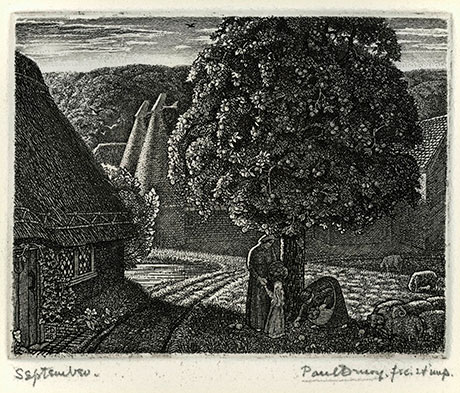
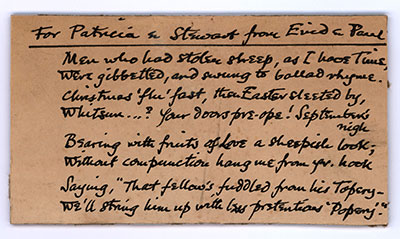
| |
ALFRED PAUL DALOU DRURY P.R.E.
London 1903 – 1987 Nutley, Sussex
Son of the sculptor Alfred Drury, it was perhaps the result of losing an eye in a shooting accident at the age of eleven, that Paul Drury followed a career in two-dimensional graphic art.
He enrolled at Westminster School of Art in 1918 and from 1921 attended Goldsmiths, where successively first Frederick Marriott, then Malcolm Osborne and finally Stanley Anderson were his tutors. Later he returned to Goldsmiths to teach, becoming Principal.
At Goldsmiths College Drury was a fellow student of Graham Sutherland, William Larkins, Bouverie Hoyton and Robin Tanner and shared their discovery and delight in the romantic pastoralist etchings of Samuel Palmer. With Sutherland he was invited to visit Frederick Griggs, another Palmer enthusiast, in Chipping Campden in 1926, taking plates to be printed on the Dover’s House press. However, Drury’s main concern always was portraiture; he made only a few intensely and beautifully needled pastoralist landscapes, chief of which is (the currently seasonal) September.
Drury was elected an Associate of the R.E. in 1926 and a Fellow in 1932. He served as President from 1970 to 1975; the first for sixty-five years not to be associated with the Royal College of Art. In his history of the Society Martin Hopkinson describes Drury as a reforming president. Until his Presidency the Society remained much in the late Victorian gentleman’s club mould established by Haden. Drury wish to make closer contact with the members and sent out a regular ‘letter from the President’, amusingly nicknamed by Harry Ecclestone the Epistle of Paul.
Drury tried to extend the breadth of interests of the Society and suggested they absorb the Senefelder Club and welcome in lithographers, but was over-ruled. It was under his watch that the Print Collectors’ Club decided to return to their original tradition of specially commissioning prints from members for the annual presentation plates, rather than, as had developed over time, selecting the prints from the Annual Exhibitions.
September
Garton 24 xii/xiii
102 x 131 mm
Original etching, 1928.
The plate signed with initials and dated.
Signed in pencil, as author and printer, and entitled.
First published state, 1928, edition of 75 plus 8 proofs.
Printed on stout cream wove, a little time-stained at the edges of the sheet.
£3250
Drury at his most Palmeresque, though the figures are loosely based on a drawing by Jean-François Millet which Drury owned.
This impression was given to friends of Drury and his wife and was accompanied by a poem
For Patricia & Stewart from Enid & Paul
Men who had stolen sheep, as I have time,
 Were gibbetted, and swung to ballad rhyme. Were gibbetted, and swung to ballad rhyme.
Christmas ‘flu’ fast, then Easter sleeted by,
 Whitsun…? Your doors pre-ope!
September’s nigh Whitsun…? Your doors pre-ope!
September’s nigh
Bearing with fruits of love a sheepish look;
 Without compunction hang me from yr. hook Without compunction hang me from yr. hook
Saying “That fellow’s fuddled from his Topery-
 We’ll string him up with less pretentious ‘Popery’ ”. We’ll string him up with less pretentious ‘Popery’ ”. Return to top ^ |
|
|
|
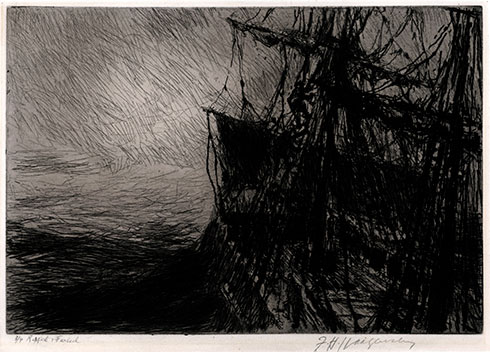
|
|
FREDERICK HANS HAAGENSEN
Grimsby 1877 – 1943 Cheltenham Hospital
Haagensen was self-taught as an etcher, taking it up in 1924, some time after his second marriage, to Audrey Bussel, twenty years his junior.
Many years later she wrote an article about his prints for the Journal of the R.E. commenting that it was “always, atmosphere interested him rather than detail…”.
Haagensen worked directly into the copper, either outdoors in front of his motif, or in the studio from memory or imagination. There were no preparatory drawings, he sought – “Spontaneity – lively line – freshness…”.
Haagensen built his own etching press.
Reefed and Furled
241 x 352 mm
Original drypoint, c1930.
Signed in pencil, entitled and numbered 3/ 4.
On cream laid paper, trimmed in the margins.
£500
Haagensen as a child and young man often accompanied his father on sea trips to Norway.
Norwegian consul in Grimsby, Haagensen senior was Norwegian by birth. He was a boat owner and imported timber from Norway.
Return to top ^ |
|
|
|
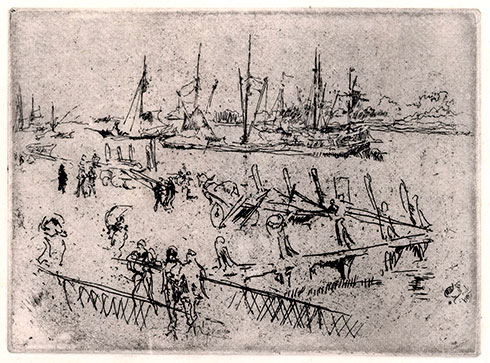 |
|
JAMES McNEILL WHISTLER
Lowell, Massachusetts 1834 – 1903 London
Whistler made three small etchings of Dordrecht in 1886, none of which were published. Only one, Dordrecht, was exhibited in Whistler’s lifetime, and he is known to have sold an impression in 1886 to Thomas McLean.
Glasgow know of only twelve impressions of Little Dordrecht, which are mainly in museum collections. Of these, only one is definitely period and printed by Whistler, being trimmed to the plate with a tab for the pencil ‘signature’ (butterfly).
Mortimer Menpes acquired the plate after Whistler’s death, and probably printed the few impressions which changed hands in 1904.
In the late 1970’s the plate came into the possession of Lott & Gerrish, who printed a few proofs before selling the plate to a German collector. No further impressions have been taken.
Little Dordrecht
Glasgow 260 only state; Kennedy 241 (no information)
94 x 130 mm (plate); 128 x 177 mm (sheet)
Original etching, 1886.
The plate signed with the butterfly.
A later impression, presumably one of the five proofs printed in 1977 for Lott & Gerrish.
On fine cream Barchem Green ‘Crispbrook’ watermarked laid paper.
Printed with plate tone.
£750
A view of the quayside along Merwekude from near the Bellevue Hotel, Dordrecht.
Return
to top ^ |
|
|
|
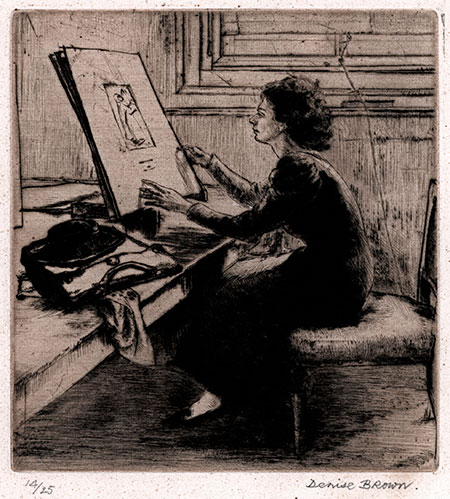 |
|
DENISE BROWN R.E.
1911 – 1998 Oxfordshire
Denise Brown wrote of her work and opinions for the R.E. Journal for 1983
… remembering precisely the moment of addiction to engraving. For me it all began at Harrow Art School, when my attention was drawn to details of a British Institution Scholarship in Engraving.
I thought it was at least worth submitting some examples of my work and when, to my surprise, I was successful I soon found myself in a small and happy band in the Engraving School of the Royal College of Art, working under the direction of Malcolm Osborne and Robert Austin.
L’Etudiante or The Print Room
189 x 175 mm
Original drypoint, 1936.
Signed in pencil and numbered 14/25.
A rich impression printed in umber with plate tone on thin cream laid paper watermarked hand made.
Dedicated, at a later date, in pencil, “The Print Room” this impression for Michael & Catriona (Blaker) with my best wishes.
Sold
An impression was exhibited at the Royal Academy in 1936.
A familiar scene (and self-portrait?) in the Print Room of the V & A, which was in the adjacent building to the Royal College at South Kensington.
Brown had gained her R.C.A. Diploma in 1935 and before taking up a Travelling Scholarship in 1936, she stayed on at the R.C.A. as a student demonstrator.
Return
to top ^
|
|
|
|
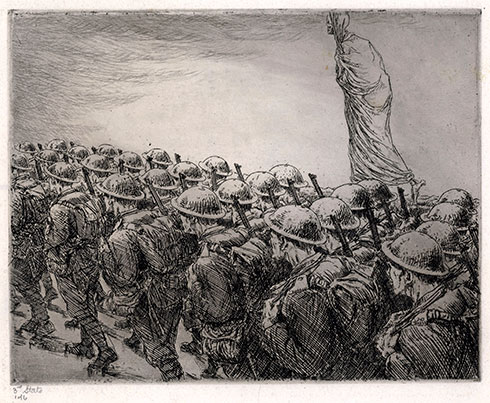 |
|
PERCY JOHN DELF SMITH
1882 – 1948 London
Smith was posted to the Somme in 1916 as a gunner with the Royal Marines. Unauthorised sketching was forbidden, but Smith was fortunate in having a sympathetic Captain who allowed him to continue. In 1917 his parents successfully smuggled etching plates out to him in the pages of a magazine and he began his ‘Thiepval etchings’, actually drypoints, which, on leave, he was able to print at Southampton Art Club.
It was the year after the War ended that Smith produced his most famous War etchings: the series of seven that comprise The Dance of Death; powerful anti-war images with the allegorical figure of Death, inspired by the medieval concept, which had gained momentum in the 14th century during the devastation of the Hundred Years’ War and the epidemic of the Black Death, an ‘echo’ of the 1918 influenza pandemic which Smith himself experienced.
Death Marches
Plate 2 of The Dance of Death
198 x 250 mm
Original etching and drypoint, 1919.
An unsigned proof, one of six, in the 3rd state.
Before the signature and date in the plate.
Annotated by the artist in pencil 3rd state 1of 6.
Printed with plate tone on cream wove.
£1000
Return
to top ^
|
|
|
|
|
|
|
|